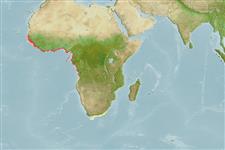Teleostei (teleosts) >
Gobiiformes (Gobies) >
Eleotridae (Bully sleepers)
Etymology: Eleotris: The name of a Nile fish, eleotris (Ref. 45335).
More on author: Duméril.
Environment: milieu / climate zone / depth range / distribution range
Ecology
Marine; freshwater; brackish; demersal; amphidromous (Ref. 46888). Tropical; 22°C - 28°C (Ref. 13614)
Eastern Atlantic: widespread from Sierra Leone to Angola (Ref. 57413, 81660), its northern range may extends to Senegal (Ref. 57413). Reported southward up to the Kunene in Namibia (Ref. 33587). Also known from the islands of the Gulf of Guinea (Ref. 10812), including Bioko, Annobon (Equatorial Guinea) and Sao Tome and Principe (Ref. 81660).
Size / Weight / Age
Maturity: Lm ? range ? - ? cm
Max length : 27.5 cm TL male/unsexed; (Ref. 130826)
Dorsal spines (total): 7; Dorsal soft rays (total): 8 - 9; Anal spines: 1; Anal soft rays: 8 - 9. Diagnosis: 53-68 scales in longitudinal series on flanks, plus up to 13 scales on caudal fin base; 17-24 (usually 18 or more) scales in rearward transverse series (Ref. 57413). No discrete dark spot present on upper pectoral fin base, if dark pigment present, not distinct from pigment on nape; sensory papillae on upper rear field of opercle form a forked row (Ref. 81660).
Occurs in coastal rivers, lagoons, creeks, estuaries (Ref. 6802, 57413, 81660) and mangrove areas (Ref. 6802, 57413). Maximum reported total length 265 mm (Ref. 6802).
Life cycle and mating behavior
Maturity | Reproduction | Spawning | Eggs | Fecundity | Larvae
Harrison, I.J., P.J. Miller and F. Pezold, 2003. Eleotridae. p. 670-690 In C. Lévêque, D. Paugy and G.G. Teugels (eds.) Faune des poissons d'eaux douce et saumâtres de l'Afrique de l'Ouest, Tome 2. Coll. Faune et Flore tropicales 40. Musée Royal de l'Afrique Centrale, Tervuren, Belgique, Museum National d'Histoire Naturalle, Paris, France and Institut de Recherche pour le Développement, Paris, France. 815 p. (Ref. 57413)
IUCN Red List Status (Ref. 130435: Version 2024-1)
Threat to humans
Harmless
Human uses
Fisheries: of no interest
Tools
Special reports
Download XML
Internet sources
Estimates based on models
Preferred temperature (Ref.
123201): 23.4 - 27.9, mean 26.5 °C (based on 64 cells).
Phylogenetic diversity index (Ref.
82804): PD
50 = 0.5000 [Uniqueness, from 0.5 = low to 2.0 = high].
Bayesian length-weight: a=0.01230 (0.00687 - 0.02202), b=3.17 (3.01 - 3.33), in cm total length, based on LWR estimates for this species & (Sub)family-body (Ref.
93245).
Trophic level (Ref.
69278): 3.8 ±0.3 se; based on size and trophs of closest relatives
Resilience (Ref.
120179): Medium, minimum population doubling time 1.4 - 4.4 years (Preliminary K or Fecundity.).
Fishing Vulnerability (Ref.
59153): Low vulnerability (18 of 100).
